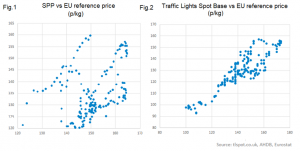While EU pig prices have been rallying strongly since the end of March, leaving the British Standard Pig Price (SPP) lagging behind, the AHDB has looked at why the SPP features as the main reference price in many contracts.
While EU pig prices have been rallying strongly since the end of March, leaving the British Standard Pig Price (SPP) lagging behind, the AHDB has looked at why the SPP features as the main reference price in many contracts.
AHDB highlighted that other commodity markets often have sizeable spot markets that generate reference prices. These spot markets are either centrally organised or have widely adopted common terms and conditions of trade.
Metals, energy markets and some agricultural commodities trade this way. Market participants can either trade directly on the spot market or negotiate a long-term contract. Duncan Wyatt, AHDB’s lead analyst said that contracts typically still reference the spot market, but reduce exposure to volatility.
“However, the spot market for pigs in Britain is only small,” he said. “In the absence of another widely representative measure, it is quite understandable why the SPP is commonly used as a reference price in pig contracts.”
Looking at what influences the SPP behaviour, Mr Wyatt said: “With relatively few pigs traded on the spot market, we’d expect spot prices to make up only a limited share of the SPP in comparison to contract prices. If then, contract prices are heavily based on the previous week’s SPP, the effect of other factors that can move the market is dampened. This explains why the SPP is “slow” to move.”
Regarding what moves the SPP, Mr Wyatt said: “This does not mean that the spot market for pigs isn’t influential. An indicative spot price for British pigs is the Traffic Lights Spot Base. We all know the British market is closely linked to the EU market. However, there is almost no relationship between movements in the SPP and European prices on a week-to-week basis (fig. 1).”
The Traffic Lights Spot Base provides sellers who have one-off loads of spot pigs (as opposed to regular weekly supplies) with a realistic minimum base price, Mr Wyatt said.
There appears to be a much stronger positive relationship between the Traffic Lights Spot Base and European prices (fig 2).
Mr Wyatt added: “So, perhaps we can think of the GB spot price as the way the British market transmits price signals about the supply/demand balance in the wider EU.
“So, although spot prices represent only a small share of the prices that go into the SPP, they are probably the main factor that drives changes in the SPP. Of course, other factors included in some contracts will also play a part. These include variable weekly contributions from buyers and certain production costs.”






